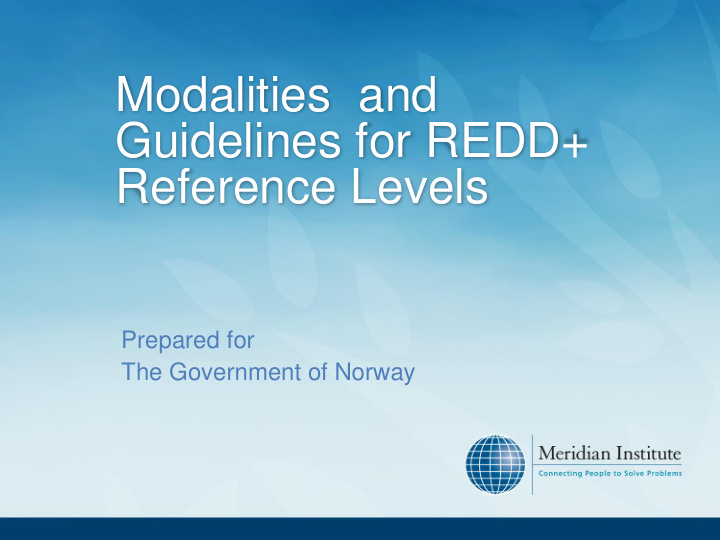



Modalities and Guidelines for REDD+ Reference Levels Prepared for The Government of Norway
Authors Arild Angelsen Norwegian University of Life Sciences & CIFOR Doug Boucher Union of Concerned Scientists Sandra Brown Winrock International Valérie Merckx European Forest Institute Charlotte Streck Climate Focus Daniel Zarin (Project Leader) Climate and Land Use Alliance 2
Acknowledgments Peter Aarup Iversen Manuel Estrada Porrua Erika Oord Marco Albani Mochammad Farhan Helmy Yaw Osafo Ken Andrasko Jose Carlos Fernandez Jim Penman Kemen Austin Horst Freiberg Per F I Pharo Tasso Azevedo Alfred Gichu Catherine Potvin D James Baker Peter Graham Audun Rosland Girma Balcha Nora Greenglass Lucio Santos William Boyd Bronson Griscom Maria Sanz Sanchez Josefina Braña Varela Pablo Gutman Sebastian Scholz Michael Bucki Ragna John Osvaldo Stella Martins Augusto Castro Promode Kant Bernardo Strassburg Andrea Cattaneo Jagdish Kishwan Doddy Surachman Sukadri Bas Clabbers Antonio La Viña Naomi Swickard Tim Clairs Donna Lee Victoria Tauli-Corpuz Steve Cornelius Cyril Loisel Natalie Unterstell Pham Manh Cuong Fabien Monteils Andrew Ure Andreas Dahl-Jørgensen Daniel Nepstad Gerardo Vergara Asenjo Florence Daviet Michael Obersteiner Michael Wolosin Christine Dragisic Lydia Olander 3
Goals – Inform SBSTA and COP-17 Stage I Assess issues that UNFCCC negotiators need to address to develop modalities for REDD+ Reference Levels and Reference Emissions Levels (RLs) Stage II Propose guidelines for RLs for REDD+ for developing countries as part of UNFCCC modalities. 4
A REDD+ Reference Level is a benchmark for monitoring progress in reducing emissions Reference (Emission) Levels (RLs/RELs) are business-as-usual (BAU) baselines against which actual emissions are compared. Emission reductions are estimated as the difference between RLs and actual emissions within an established period. 5
Functions of RLs Inform on the effectiveness of REDD+ interventions. RLs underpin the credibility of REDD+. The process of establishing RLs can inform development and implementation of (sub)national REDD+ policies. RLs can inform the determination of results-based payments for REDD+. 6
Modalities and Guidelines for RLs Modalities: a set of binding requirements included in a COP decision formulating rules and standards Guidelines: a set of principles, criteria and steps included in a COP decision that assist countries in preparing a submission or meet an objective formulated by the COP 7
Developing a RL Start from IPCC categories Develop plan and procure the data Historic emissions and removals needed Develop activity data and emission factors Identify relevant national circumstances National circumstances Bring robust and reviewed evidence justifying adjustments 8
IPCC Reporting Principles Transparency Clear and fully described assumptions and methods Completeness Relevant pools and activities included Consistency Accepted standards of carbon accounting followed Comparability Comparisons among countries should be straight-forward Accuracy Avoid bias, reduce uncertainty.
Scope of REDD+ RLs • Forests converted to other lands o Deforestation • Forests remaining as forests o Forest degradation o Conservation of forest carbon stocks o Sustainable management of forests o Enhancement of forest carbon stocks in existing forests • Other lands converted to forests o Enhancement of carbon stocks through A/R 10
Historic Emissions and Removals 11
Data collection examples 4. Identify drivers of forest 2. Select which cover change 1. Definition of pools to include Forest- determines which lands to include 15% cover 3. Measures of C stocks 5. Interpret remote 30% cover sensing imagery 12
National Circumstances: General adjustments considered Forest Transition Stage (forest cover, GDP) Drivers (e.g. agricultural commodity prices) 13
National Circumstances: Conclusions To date there is insufficient empirical evidence support generalized adjustments to RLs from historic emissions and removals Case-by-case adjustments should be supported by robust and verifiable empirical data, e.g. evidence of implementation of national policies that have major impacts on future forest use Equity-based adjustments (e.g. forest cover, GDP) to influence REDD+ financing should be considered separately from adjustments to RLs. 14
Subnational RLs Parties can develop subnational RLs that constitute a step toward adopting national RLs. Subnational RLs should follow the same principles and steps laid out here for national ones. Subnational RLs should follow a common set of criteria that facilitate the subsequent reconciliation of RLs on the national level. 15
UNFCCC adoption of RLs RLs could be adopted through one of several alternative procedural approaches, including: • A single-undertaking top-down process • A country-driven sequential process • Hybrid process: political decision at the international level and consolidation with country submissions 16
Temporal Validity of RLs RLs may be: • Re-negotiated within a specific timeframe • Re-submitted for review and adjustment • Automatically revised • Reviewed every X number of years e.g. in the context of national communications 17
Potential Outline for REDD+ RL Modalities: A Suggestion for SBSTA Principles Guidelines on RL Development Data Submission Notification of Preliminary RLs International Adoption of Final RLs Data Administration 18
REDD+ Reference Level reports are available online: www.redd-oar.org
Recommend
More recommend